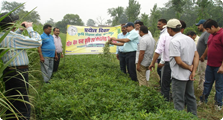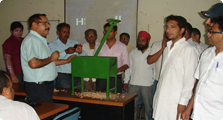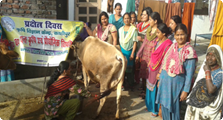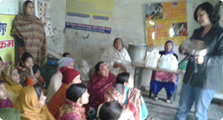Success Story
Case Studies-1
Processing and Packaging
Krishi Vigyan Kendra, Kashipur under the concept of minimal processing unit is organizing trainings and providing technical information and guidance to rural women on processing and packing of spices. Processing of spices at domestic level is attracting women and they are feeling motivated to start this as home based enterprise. Under the minimal processing unit, established at KVK by ICAR, women are being trained and given method demonstration or grinding of through grinding machine and finally packing them women are being trained and encouraged for processing of turmeric (haldi) and coriander through grinding machine, technical knowledge and spices of packaging and information on marketing of the same. KVK has conducted 3 days training programme on processing of haldi and coriander, in which rural women of Himmatpur village, block kashipur have participated and gained technical know how.
Scientists have also conducted field visit which created awareness among women on processing of spices for income generation woman of these village also motivated women of other villages on this aspect. In this context two women-Smt Kiran Devi, W/o Sri. Shravan Kumar and Smt. Reena Devi W/o Niranjan Singh contacted home scientists of the centre and gained technical information on processing of spices. This technique attracted the two women and they started this as on income generation enterprise at their own level. These women in future want to establish this practice as a source of regular income generation enterprise by involving more women.
Exposure visit organized by KVK Kashipur
Three days exposure visit to Karnal was organized by KVK, Kashipur from 21-23 Feb, 2015. Two subject Matter Specialist along with 20 farmer from various villages such as Dhaki, Banskhedi, Brahmnagar, Harinagar, shanitipuri, sitarganj, Panderi etc. of Udham Singh Nagar Uttarakhand visited Institution in the field of Agriculture & Animal Husbandry at Karnal, CSSRI, SBI, DWR & NDRI. These were visited to enhance the performance level & better management of Agricultural system. As a component of capacity building exposure visit has act as an important intervention to improve farmers competencies and increase in productivity with a purpose to accurate the rate of agricultural development.
Participation in Kisan Mela
Krishi Vigyan Kendra, Kashipur participated in farmers fair organized by GBPUAT, Pantnagar (October, 2014 and March, 2015) and a three days kisan mela was organized by Danik Jagran at Rudrapur from 22-24 February, 2015 inaugurated by the Hon’ble Chief Minister Shri Harish Rawat, Uttarakhand State. Krishi Vigyan Kendra, Kashipur had put up stall and exhibited latest technologies and advancement talking place in the field agriculture and allied sector for wider dissemination of technology. Such as use of revolving stool for milking to reduce drudgery among farm women and crop production techniques in pulse crop and cereal crops. Awareness was also created on cultivation of groundnut during summer season in place of summer rice. District Magistrate and Chief Development Officer, Rudrapur visiting the stall during fair.
Priority/Thrust Areas
| S.N. | ||
|---|---|---|
| 1 | Name of the Farmer | Arun Kumar Kamboj |
| 2 | Address i. Village ii. Post iii. Tehsil iv. District v. State |
Chakarpur Bajpur Bajpur Udham Singh Nagar Uttarakhan |
| 3 | Contact Details | 9897049791 |
| 4 | Details of the farm i. Size ii. Location iii. Water availability etc |
3.5 Acre (For Organic Basmati production) Chakarpur Good |
| 5 | Membership in Self-Help Group, Producers Cooperative/Company, Cooperative Society etc (give details): | |
| 6 | Names of the Central Sector/State Schemes utilized by the farmer and the period: | NIL |
| 7 | Technologies/Good Agricultural Practices/Facilities/Benefits obtained with details: | He carried out all the work of pheromone trap by his claps thus, naming the traping insects Hast Taal Method. He specifies that for effective insect control, the farmer should visit his paddy field after an interval of 15 days and the insect must be killed immediately. In an acre of land the number of insects hardly exceeds 10. He observed and killed only 12 insects in his half hectare of crop. This resulted in easy and effective control of stem borer in organic basmati in eco-friendly and cost effective manner. Classification of the insects in paddy : The insects found in the fields of paddy can be classified into two classes: Vegetarian and non vegetarian. Vegetarian insects destroys/infects stem, pods, leaves even the complete plant of paddy. Whereas, non vegetarian insects eat the eggs and larvae of vegetarian insects. Therefore, the non vegetarian insects are our friends. Mr. Kamboj has a view that there is no chemical still developed which can destroy only the harmful insects. The insect is inactive stage on leaves of paddy before 10 AM. It is at about 30-40 feet distance. Sometimes the insect is at the lower side of leaves therefore one must ensure its presence on both the sides of leaves. Usually the killing of the insect by clapping results in skin allergy therefore it is better to take precautionary measure as gloves, edible oil, etc. After onset of pods in the crops there is no need to control the insect as it is difficult for the insect to penetrate hardened stems of the plants.
|
| 8 | Details of results obtained due to the adoption of technologies (Season-wise crops grown, techniques adopted, results achieved etc.): |
|
| 9 | Marketing strategy | Access to market (through private, cooperative, contract farming etc.) Contract farming for: K.R.B.L. Kohinoor Foods Shreshtha Foods |
| Marketing strategy | -Export market (details of exports made)The produce by contractors is exported to Asian countries | |
| 10 | Factors contributing to success | Contract farming with exporters resulted in better prices thus, good monetary gain Membership with various self help groups and farmers club resulted in cooperative efforts |
| 11 | Any other relevant information | He has some other inventions to his credit as: |
Glimpses of Fields of organic paddy cultivation, Village: Chakarpur, Block: Bajpur, Udham Singh Nagar, UK

Case Studies-2
Value Added Products (Farm Innovation)

Personal Profile
Name of Farm Women :Suseela Devi
Age : 38 Years
Education (highest level and subject) : 5th Passed
Name of SHG Started : SAGUN SHG 2008
Designation in SHG : President
Place : Jhankat Village, U.S. Nagar, UK
Contact No. : 9411168213
Title of the success story
Suseela Devi, 38 belong to a very poor family. She was ignorant of any source of income as well as knowledge about any skill for livelihood security. In 2008, she got associated with Bhoomi Project from where she inculcated the knowledge about SHG formation in herself. She was keenly inspired to join it and thus she started a SHG named Shagun and now she is president of the group. The KVK Kashipur, U.S. Nagar trained Suseela and her group for various entrepreneurial skills and also skills for various value added products like herbal gulal, dehydrated products, snacks items and sweets in the year 2009. Her group has exhibited various products at different places like KVK Kashipur, TATA motors Pantnagar etc. This resulted in earning of net profit Rs. 5500/- Every group member is getting their morals high to enhance their own and their family status. Recently, the group got association with Handicrafts Ministry for preparing indigenous handicrafts there by resulting in 2000-4000/- monthly income for each family depending on their amount of work.
Practical utility
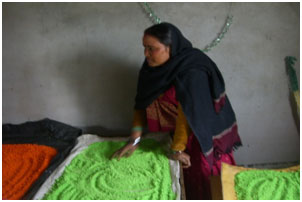
Picture showing the innovation/activity/model
Case Studies-3

Personal Profile
Name of farmwomen : Parveen Devi
Age : 31 Years
Education (highest level and subject) : 5th Passed Name of SHG
Started : PRIYANKA SHG 2008
Designation in SHG : Member
Place : Jhankat Village U.S. Nagar, UK
Contact No. :
Title of the Success Story
Parveen Devi, 31 belong to a very poor family. She was ignorant of any source of income as well as knowledge about any skill for livelihood security. In 2008, she got associated with Bhoomi Project from where she inculcated the knowledge about SHG formation in herself. She was keenly inspired to join it and thus she started a SHG named Priyanka. She got training from KVK Kashipur, U.S. Nagar for various entrepreneurial skills in the year 2009. The group liked to utilize their ITK of handicraft making products for income generation. Thus, the group availed a loan of Rs. 6583/- from Bhoomi project and started handicraft making. Her group has exhibited various products at different places like KVK Kashipur, TATA motors Pantnagar etc. The group has collaboration with Handicrafts Ministry for preparing indigenous handicrafts there by resulting in 2000-4000/- monthly income for each family depending on their amount of work.
Practical utility
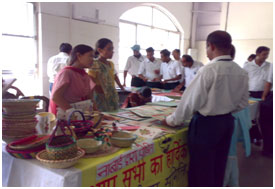
Picture showing the innovation/activity/model/h4>
Case Studies-4
Upliftment of economic status of rural farmer through fish culture

Sri Udaiveer singh, a young progressive farmer belong to village Brahmnagar, Block Kashipur, District Udhan Singh Nagar Uttarakhand, from last few years, he was effectively involved in agricultural activities like crop production, vegetable production and animal husbandry. He was very hard working person but unable to draw maximum benefit from these agricultural activities. In 2008, five days training programme on fisheries was being organized by KVK, Kashipur. He eagerly participated in fisheries training programme and received detailed and valuable information on fish culture. Influenced by the KVK fisheries Scientist he decided to do work on this aspect for which initially constructed a fish pond of 0.5 Acre on his land with the support and technical guidance of fisheries Scientist at KVK, Kashipur. In the meantime also attended training programme organized by KVK,Kashipur on various aspects of fish culture right from pond construction, pre stocking management , feed and feeding management to harvesting.
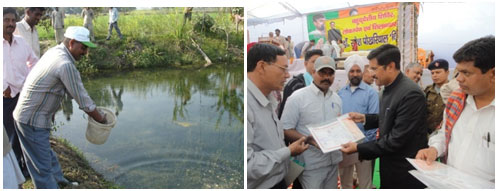
After constriction , application of cow dung and then lime to disinfect the pond carried out by him as pre-stocking management, pond subsequently stocked with 5000 fingerlings of six species i.e. roho ,caltla, mrigala,silver carp, grass carp and common carp fingerlings, he efficiently and regularly conducted every activity under the guidance of KVK Scientist to manage the pond. After a culture period of 11 month 1420 kg of fish production was achieved, total expenditure involve during culture was Rs 20900 in seed, feed, manure and lime after selling the fish at the of Rs 65/kg received grass income of Rs 92820 resulted net income of Rs 71920.
As a result farmers of nearby villages approaches him and after that KVK, Kashipur for technical guidance more than 12 pond of around 5 ha area were constructed in the vicinity with help of KVK, Kashipur and District fisheries department and more are in the process of construction. Sri Udaiveer singh also received “Kisan Sri” Award and cash prize of Rs 10,000 for the Best fish farmer in the Block by ATMA.
His words to fellow farmers & unemployed youth:
If fish farming is taken up with appropriate technological acquaintance, it is very remunerative even unemployment crisis of rural youth can be solved. For associated fishery farmers who are just mere possessor of ponds without income, management trainings is required to equip with the most recent expertise so as to become an owner of a productive pond.
Case Studies-5
Udham Singh Nagar is a hub of Frozen pea in India: A successful case
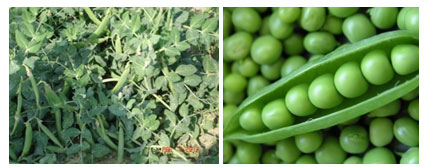
Pea cultivation is becoming highly remunerative in US Nagar and fits best in traditional Rice- wheat cropping system of Distt. Rudrapur Mandi is becoming a biggest feeder of Azadpur mandi of New Delhi for the last 5/6 years. Establishment of frozen and dehydration plants in the regions has created backward demand for farmers and retailers. In the last five years area enhances in US Nagar was exponential increase in four time and more than 20,000 ha areas under pea cultivation in the state (Dept. of Horticulture), Govt. of Uttarakhand, 2010). It is estimated that total raw material requirement of green peas are consumed is 81000 MT per year. Uttarakhand is utilizing 35000 MT of raw materials against total demand of country with production of 95000 MT of country. It contributes 35% Approx total requirement of frozen peas in the country, therefore, Uttarakhand has been recognized as ‘frozen pea hub’ in the country.
State Government liberal policies and farmers/entrepreneurs initiatives have made a tremendous progress in the field of food processing sectors. IQF is a commercially utilized technology used in vegetable crops. US Nagar is the leader in adoption and creation of facilities with 11 units in the distt. A huge investment occurred in this sector, a total sum of Rs. 11702 lacs has done with assistance of bank loan Rs. 7196 lacs has been forwarded to entrepreneurs. Mainly vegetables and some fruits are included in these projects.
Dr. A.K. Sharma, Officer Incharge of KVK-Kashipur has the opinion of pea cultivation was not confined to US Nagar only, but area under pea cultivation spread in adjoining area in Uttar Pradesh. A huge quantity of 3000 MT of green peas is sold/processed/transported per day during the peak season. Dramatic change occurred in pea business and farmers are becoming business managing their resources. Uttarakhand is really a beneficiary in food processing sector, due to central/state govt’s liberal policies to provide importance for industry sectors.
In the past tremendous investment had undergone to establish various units in the state. Especially, private sector is pioneer in this field with financial assistance of TMNE (MM-4) and MOFPI and state Govt. has acknowledged the entrepreneurs in affirmative approach. The investment in Private Sector has increased in many folds. This has created a backward demand in the production of fresh pea in and around areas in a big way in the state, and consumption of green peas increased many peas increased many folds. There was a strong backward linkage developed between processor & producer, which in return created direct and indirect employment to the local people around industrial areas of the state.
Case Studies-6
Processing and Packaging
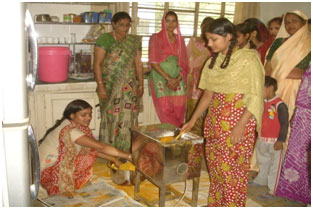
Krishi Vigyan Kendra, Kashipur under the concept of minimal processing unit is organizing trainings and providing technical information and guidance to rural women on processing and packing of spices. Processing of spices at domestic level is attracting women and they are feeling motivated to start this as home based enterprise.
Under the minimal processing unit, established at KVK by ICAR, women are being trained and given method demonstration on grinding through grinding machine and finally packing spices women are being trained and encouraged for processing of turmeric (haldi) and coriander through grinding machine, technical knowledge and spices of packaging and information on marketing of the same.
KVK has conducted 3 days training programme on processing of haldi and coriander, in which rural women of Himmatpur village, block kashipur have participated and gained technical know how.
Scientists have also conducted field visit which created awareness among women on processing of spices for income generation. Woman of this village also motivated women of other villages on this aspect. In this context two women-Smt Kiran Devi, W/o Sri. Shravan Kumar and Smt. Reena Devi W/o Niranjan Singh contacted home scientists of the centre and gained technical information on processing of spices. This technique attracted the two women and they started this as on income generation enterprise at their own level. These women in future want to establish this practice as a source of regular income generation enterprise by involving more women.
Innovation
Status of Soil Testing Laboratory (Soil sample tested Nos.) : Under progress
Status of ERNET facility (comments): Established at kvk (functional)


